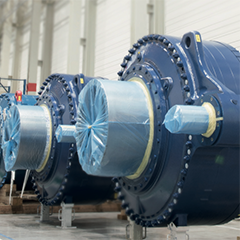PES is delighted to bring you this latest advanced technology solution from ZF Wind Power. Over the last few years total wind turbine noise, which is mainly generated by the interaction of the wind and the wind turbine structure, has changed from being one of the properties of a wind turbine to a true differentiator between different wind turbine OEMs: the less noise the wind turbine generates, the more wind turbines can be placed on the same piece of land without violating the prevailing noise regulations.
To achieve this, wind turbine OEMs are investigating among other things reducing overall noise levels by utilising optimised low noise blade design using e.g. serrations and improving controller strategies to include a wide variety of low noise modes.
As the overall wind turbine noise is used to mask the noise coming from the mechanical components inside a wind turbine such as the generator and the gearbox, these noise sources also need to be optimised. The low noise blade designs, which are still being studied, have a direct impact on the overall wind turbine noise and thus require the mechanical noise to be reduced at the same pace. Next to that, the increased number of low noise modes, which typically just reduce operating speed while maintaining normal torque, widen the overall operating envelope.
As a consequence of this, the overall wind turbine noise, which is mainly linked to the rotor speed, reduces significantly. By doing so the mechanical noise also needs to be optimised further. Mechanical noises originating from the drivetrain in conditions such as nominal torque and nominal operating speed, which were previously completely masked by overall wind turbine noise, now are not masked anymore by the overall wind turbine noise due to this reduced operating speed.
ZF Tonal Free Wind Turbine process
To reduce the mechanical noise originating from the gearbox, ZF Wind Power has worked out an integrated approach. This approach, called the ZF Tonal Free Wind Turbine process, is aligned with every step of the design process to guide the design towards an optimised low noise gearbox. It consists of 4 main sub-processes and has a main goal to identify, track and mitigate potential tonalities, called risks, throughout the complete drive train design.
During the first sub-process, called concept optimisation, all potential macro geometry candidates are evaluated with respect to gear excitation levels and potential tonalities caused by large torsional resonances occurring inside the defined wind turbine operating range. The main goal here is to reduce the overall excitation level and to try to shift as many global torsional resonances out of the operating range as possible. Torsional resonances still in the operating range are considered further on as tonality risks, are tracked and depending on their severity mitigated in this or in the next process step. Final selection of the resulting macro geometry from all potential macro geometry candidates is based on this assessment and other selection criteria such as rating and cost.




























